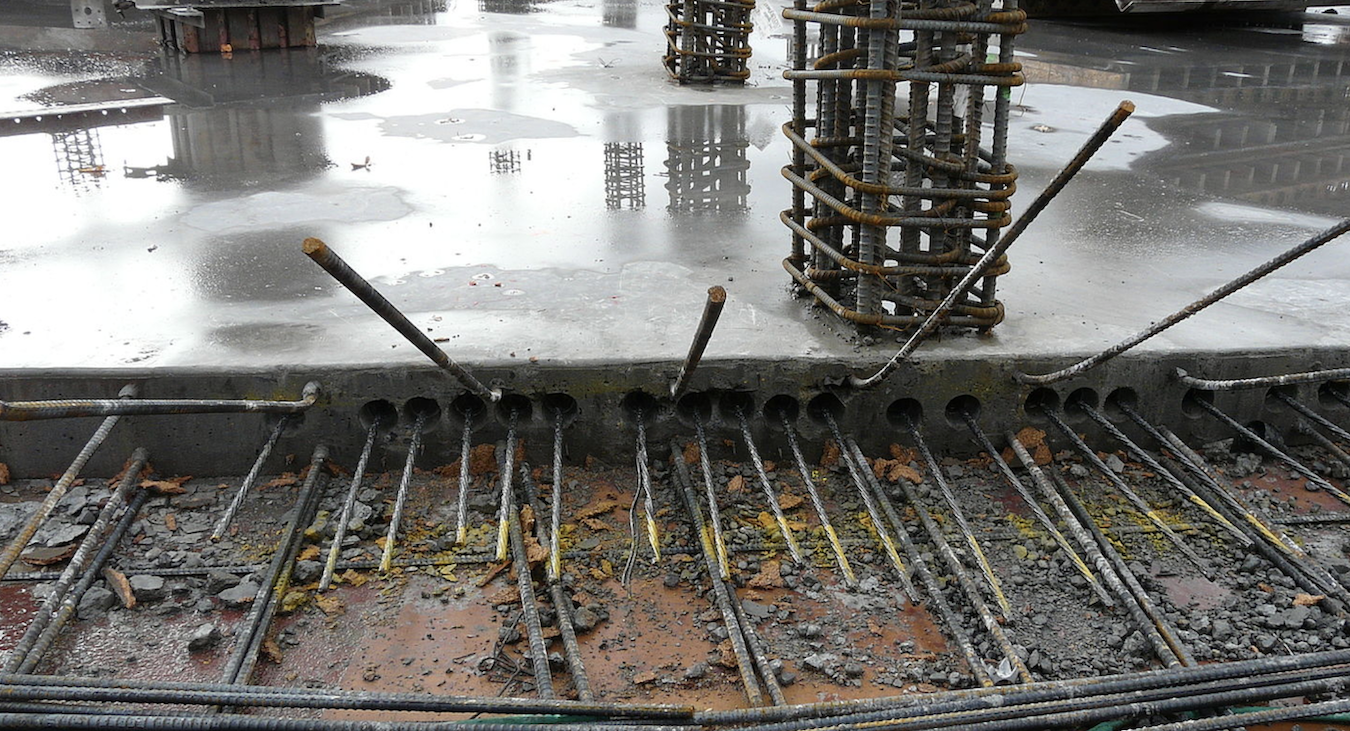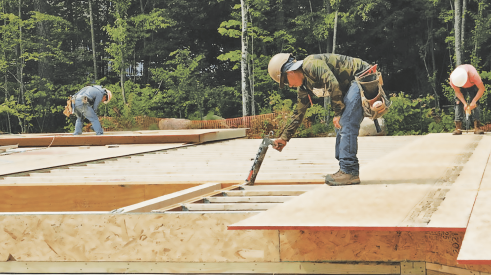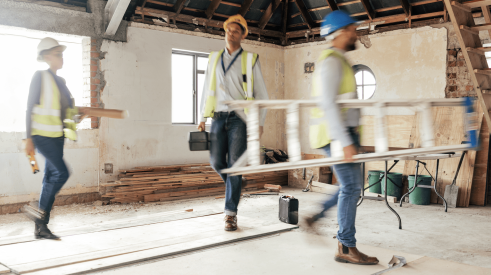Slab-on-grade foundations are one of the most popular types of foundations in the U.S. They're quick and inexpensive to build and are great in southern climates where the freezing depth in the soil is shallow. In these climates, slab-on-grade foundations work well, as long as the slab is built to a good standard of quality and performance.
Typically, the largest concern with slab-on-grade foundations is cracking. Concrete naturally experiences some cracking as it shrinks during the curing stage. These natural cracks are known as shrinkage cracks. Shrinkage cracks appear as a displacement or separation in the surface of the concrete and are hard to prevent. Shrinkage cracks aren't detrimental to the performance of a slab, but they can be unsightly and cause cosmetic damage to interior floor finishes. Concrete can also experience cracking when certain soil conditions are present. These soil conditions, which we'll discuss in a minute, require additional measures to ensure the quality and performance of the slab. One such additional measure is to reinforce the slab through a process called post-tensioning.
Post-tensioned slab reinforcement
Post-tensioning compresses concrete, enabling it to resist both shrinkage cracks and cracks caused by difficult soil conditions. Steel strands are run through the concrete in a grid pattern. Each strand is housed inside plastic sheathing that protects the steel from corrosion and allows it to move during the stressing operation. Each strand is gripped by an anchorage on each end. The combination of the strand, sheathing, and anchorages is called a tendon. As each tendon is pulled tight, the steel stretches and is held in place by the anchorage, keeping the tendon tensioned for the life of the foundation and helping the slab resist forces that act to pull it apart.
What's the cost of concrete slab cracks?
The last thing you want to throw away money on is a defect in the foundation. Defects such as slab cracks can be costly to repair after construction. Removing the interior floor finishes to make repairs to the slab is both expensive and time-consuming. Imagine removing a ceramic tile floor from the surface of a slab. Depending on the extent of the damage, you may also have to put up the homeowners in a hotel during the repair. For these reasons, the average cost to repair cracks in a slab foundation ranges from $5,000 to $10,000!
RELATED
- Preventing cold joints on concrete pours
- Concrete solutions for lurking moisture
- Proper Backfilling and Grading for a Dry Foundation
- Quality Matters: Construction best practices
Difficult soil conditions for post-tensioned slabs
In general, it's more expensive to build a post-tensioned slab-on-grade foundation than a traditional one. The reason behind the extra expense is that the foundation must be more substantial to accommodate difficult soil conditions that have inconsistent or poor bearing capacities, such as expansive and organic soils. In the U.S., post-tensioned slabs are primarily constructed in the Southwest, where there are expansive (clay) soils, and in the Southeast, where there are organic (loam) soils.
Expansive soil is a clay soil that shrinks when the water content lessens and swells when the water content increases. As the soil shrinks and swells, it creates serious problems for the home that appear as cracks that can range from small cracks to cracks that run deep, reducing the slab's strength and durability. The most extensive damage to homes occurs in areas that have a semi-arid climate where periods of rainfall are followed by periods of no rainfall, such as in Arizona. In these areas, constructing a post-tensioned slab instead of a traditional slab is a good choice, because post-tensioning strengthens the foundation, allowing it to resist the effects of shrinking and swelling soil.
If the bearing soil isn’t properly leveled and compacted, bulges result. That hampers efforts to properly post-tensioned the slab once the concrete is poured.
Organic soil is a type of soil that contains a high percentage of organic matter. Organic matter, such as grass, roots and leaves, will decay under the slab, causing the foundation to settle and crack. In general, organic soil is too compressible for a traditional slab-on-grade foundation; this type of soil can't be relied on for long-term support. As a result, it's best to construct a post-tensioned slab, giving the slab the strength to resist stresses caused by the soil.
Errors that lead to cracks in post-tensioned slabs
When errors are made on-site during the post-tensioning process, the ability of the reinforcement to prevent cracking is decreased. As a result, even though post-tensioning is meant to help prevent a slab from cracking, the slab can still crack if the tensioning process is done incorrectly. The best way to ensure this doesn't happen is to educate your construction teams on the best practices for designing and constructing post-tensioned slabs. Otherwise, issues are likely to develop, leading to costly repairs and unhappy homeowners down the road.
Some of the most common errors that cause post-tensioned slabs to crack are easy to prevent. Let's look at three.
Error No. 1: Inconsistent slab thickness
Making sure the slab is the proper thickness is very important. When the slab's thickness varies, it will resist movement during the stressing operation, preventing cracks in the concrete from closing. One reason the thickness may vary is because the bearing surface hasn't been properly leveled or compacted. When the bearing surface is uneven, it makes the bottom of the slab uneven, preventing the stressing operation from moving the slab smoothly across the ground to close any cracks that have formed.
To prevent this issue, it's best to properly level and compact the bearing soil and gravel layer prior to placing concrete. There should be an even 2- to 4-inch gravel layer on top of the soil. It's also important to ensure areas around beams are properly formed and areas where the slab thickness intentionally changes are gradual and smooth.
Error No. 2: Stressing the tendons too late
Tendons have to be stressed at a specific time during the curing stage. Stressing them too late allows the slab to advance significantly through the curing stage. At this point, the slab is too strong to allow the stressing operation to close any plastic cracks that opened up during curing.
To prevent this problem, the stressing operation should start as soon as the concrete attains the proper strength. This strength is typically reached during the first 4 to 10 days of the curing stage. Anthony Grisolia, manager of IBACOS Homebuilding Quality Consulting in Pittsburgh, stresses watching weather. “It's really important to take the weather conditions into consideration in order to properly time the stressing operation. You want to check the current weather, as well as keep an eye on weather in the coming days. With concrete, weather is an important factor, as wet or dry conditions can significantly change the timing of when you stress the tendons.” Grisolia, with almost a decade of experience in the home building industry, has assisted housing giants affected by quality issues like cracking in post-tensioned slabs in southwest markets.
Error No. 3: Incorrect installation of the slip sheet
The slip sheet (10 mil polyethylene) reduces the friction between the slab and bearing surface, allowing the stressing operation to move the slab smoothly across the ground. When the slip sheet is installed incorrectly, such as beneath the gravel layer or on top of an uneven surface, the slab resists movement, preventing the stressing operation from closing any cracks that opened up during curing. Anthony Grisolia cautions housing giants: “When the slip sheet is missing altogether or not directly under the slab, it significantly increases the need to exert extra force on the tendons in order to counteract the additional friction. As a result, you increase the likelihood for ruptured tendons.”
To prevent this issue from occurring, the bearing surface beneath the slip sheet should be level and the slip sheet should fully cover the foundation footprint. All seams in the slip sheet should overlap at least 12 inches and be sealed with 3 inches of construction tape. In addition, the slip sheet should be on top of the gravel layer, so the sheet is directly underneath the slab.
What's the lesson learned?
When all is said and done, post-tensioned slabs aren't as quick and easy to construct as traditional slabs. But when construction teams properly understand and follow the procedures set forth for post-tensioning a slab, they're adding to a foundation's lifespan and helping you hold onto your hard-fought income.
Michael Dickens is the CEO of BuildIQ, which provides online information, tools and training in home building best practices to help builders take their homes and businesses to the next level of quality and performance.
For more information, the Post-Tensioning Institute offers the “Construction and Maintenance Manual for Post-Tensioned Slab-on-Ground Foundations.” You can purchase it on PTI's website in the bookstore.
Advertisement
Related Stories
Quality Matters
5 Ways to Silence Squeaky Floors
Take these tips to heart to deliver quiet floors and satisfied homeowners
Construction
Proven Ways to Improve Jobsite Productivity
Consider these solutions for reducing cycle time, hard costs, dry runs, rework, miscommunication, and overall inefficiencies on the jobsite
HVAC
Why Pay Attention to HVAC Faults? Energy Efficiency, for One Thing
HVAC faults usually go undetected, which is a problem, since they can severely compromise a home’s energy efficiency







